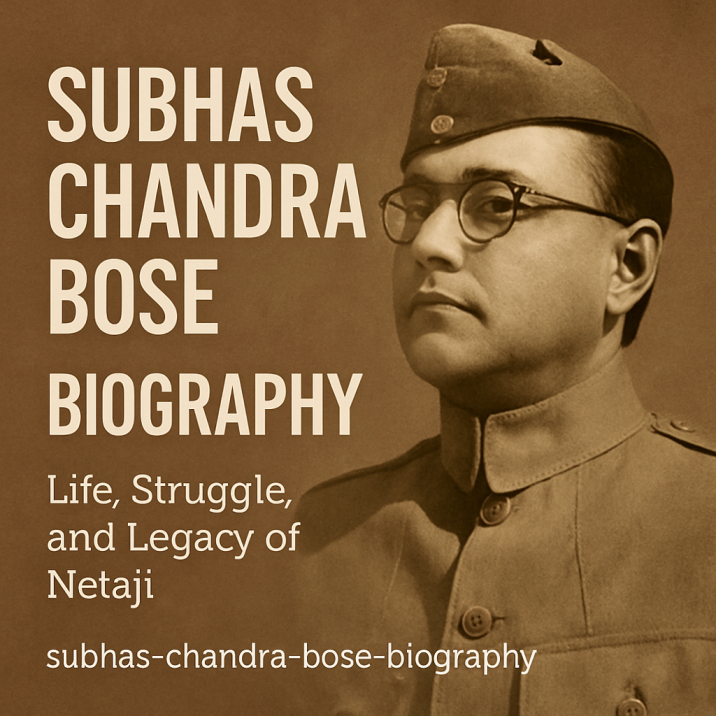Netaji Subhas Chandra Bose Biography- Life, Struggle and Legacy.
Early Life and Education
Subhas Chandra Bose, popularly known as Netaji, was born on 23 January 1897 in Cuttack, in the then Bengal Presidency of British India (now in Odisha). His father, Janakinath Bose, was a successful lawyer, and his mother Prabhavati Devi was a devout and caring woman.
Bose was a brilliant student from a young age. After completing his early education at Ravenshaw Collegiate School, he pursued higher studies at Presidency College in Calcutta. He later went to England in 1919 to prepare for the Indian Civil Services Examination, which he cleared in 1920. However, his passion for India’s freedom led him to resign from the service and return to India in 1921.
Table of Contents
Political Career and Indian National Congress
Back in India, Bose joined the Indian National Congress under the influence of Deshbandhu Chittaranjan Das. His dynamic personality and sharp intellect quickly made him a prominent leader. Subhas Chandra Bose was elected President of the Indian National Congress two times – first in 1938 at the Haripura Session and again in 1939 at the Tripuri Session.
However, ideological differences with Mahatma Gandhi and other Congress leaders led to his resignation from the Congress. While Gandhi emphasized non-violence, Bose believed that only armed struggle could uproot British rule from India.
Formation of Forward Bloc
In 1939, after leaving Congress, Subhas Chandra Bose founded the Forward Bloc, a political party that aimed to consolidate the political left and continue the struggle for independence.
Escape from India and the Rise of INA
In 1941, under house arrest by the British, Bose made a daring escape from Kolkata disguised as a Pathan. He traveled through Afghanistan, the Soviet Union, and eventually reached Germany. From there, he traveled to Japanese-occupied Southeast Asia, where he reorganized the Indian National Army (INA).
The INA, originally formed by Mohan Singh, was revived under Bose’s charismatic leadership. With his powerful slogan ‘Give me blood, and I will give you freedom‘ Subhas Chandra Bose motivated thousands of Indians to join the struggle for independence.
Azad Hind Government and the INA Campaign
In October 1943, Bose established the Provisional Government of Free India (Azad Hind Government) in Singapore. He served as the Head of State, Prime Minister, and War Minister of the Azad Hind Government. The INA, aligned with Japanese forces, fought bravely in campaigns in Burma and India.
The INA captured parts of Manipur and Nagaland, but eventually lost ground due to supply issues, monsoons, and the turning tides of World War II.

5 Important Life Lessons from Netaji Subhas Chandra Bose
Never Give Up
Even in exile and hardship, Netaji never gave up on the dream of a free India — a lesson in persistence and unwavering determination.
Nation Comes First
Netaji dedicated his entire life to the service of the nation, proving that patriotism and national pride should always be a top priority.
Courage to Stand Alone
Despite opposition within his own party, Bose followed his convictions, teaching us to stay firm in our beliefs even when alone.
Action Over Words
He believed in strong, bold action rather than empty speeches, reminding us that real change comes through deeds, not just ideas.
Unity is Strength
By uniting Indians across regions and religions in the INA, Bose emphasized that collective strength can overcome even the greatest of challenges.
Mysterious Death and Legacy
Subhas Chandra Bose reportedly died in a plane crash in Taipei, Taiwan, on 18 August 1945. However, his death remains one of the biggest mysteries in Indian history, with multiple theories and investigations over the decades.
Despite his untimely and controversial death, Netaji remains a symbol of patriotism, courage, and revolutionary spirit. His contributions to India’s freedom struggle are celebrated annually, especially on Netaji Jayanti (23 January) and INA Day.
Legacy of Subhas Chandra Bose
- INA veterans were tried at the Red Fort in Delhi in 1945, sparking massive protests and boosting the freedom movement.
- Bose’s leadership gave rise to a new sense of national pride and unity among Indians abroad.
- The popular slogan ‘Jai Hind‘, which is still widely used today, was made famous by Subhas Chandra Bose.
- His contributions are commemorated through statues, museums, airports, and educational institutions across India.
- In 2022, a grand statue of Netaji was unveiled at India Gate, New Delhi.
Final Thoughts
Subhas Chandra Bose’s life was a burning flame of sacrifice, leadership, and defiance against colonial rule. Though he chose a path different from Gandhi’s, his dedication to the motherland was unquestionable. Today, his name inspires millions to stand up for justice, courage, and national pride.
